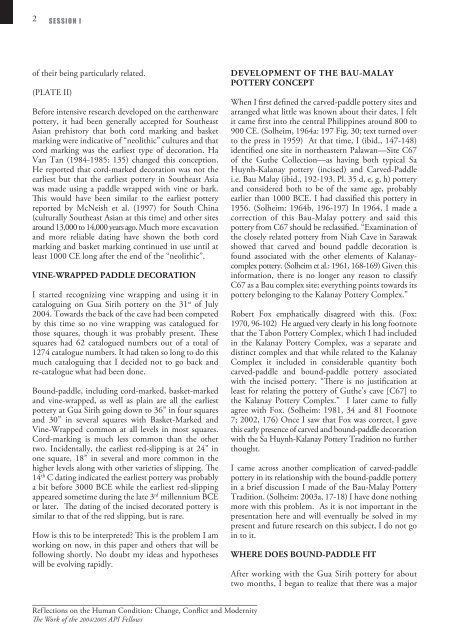Reflections on the Human Condition - Api-fellowships.org
Reflections on the Human Condition - Api-fellowships.org
Reflections on the Human Condition - Api-fellowships.org
Create successful ePaper yourself
Turn your PDF publications into a flip-book with our unique Google optimized e-Paper software.
2<br />
SESSION I<br />
of <strong>the</strong>ir being particularly related.<br />
(PLATE II)<br />
Before intensive research developed <strong>on</strong> <strong>the</strong> ear<strong>the</strong>nware<br />
pottery, it had been generally accepted for Sou<strong>the</strong>ast<br />
Asian prehistory that both cord marking and basket<br />
marking were indicative of “neolithic” cultures and that<br />
cord marking was <strong>the</strong> earliest type of decorati<strong>on</strong>. Ha<br />
Van Tan (1984-1985: 135) changed this c<strong>on</strong>cepti<strong>on</strong>.<br />
He reported that cord-marked decorati<strong>on</strong> was not <strong>the</strong><br />
earliest but that <strong>the</strong> earliest pottery in Sou<strong>the</strong>ast Asia<br />
was made using a paddle wrapped with vine or bark.<br />
This would have been similar to <strong>the</strong> earliest pottery<br />
reported by McNeish et al. (1997) for South China<br />
(culturally Sou<strong>the</strong>ast Asian at this time) and o<strong>the</strong>r sites<br />
around 13,000 to 14,000 years ago. Much more excavati<strong>on</strong><br />
and more reliable dating have shown <strong>the</strong> both cord<br />
marking and basket marking c<strong>on</strong>tinued in use until at<br />
least 1000 CE l<strong>on</strong>g after <strong>the</strong> end of <strong>the</strong> “neolithic”.<br />
VINE-WRAPPED PADDLE DECORATION<br />
I started recognizing vine wrapping and using it in<br />
cataloguing <strong>on</strong> Gua Sirih pottery <strong>on</strong> <strong>the</strong> 31 st of July<br />
2004. Towards <strong>the</strong> back of <strong>the</strong> cave had been competed<br />
by this time so no vine wrapping was catalogued for<br />
those squares, though it was probably present. These<br />
squares had 62 catalogued numbers out of a total of<br />
1274 catalogue numbers. It had taken so l<strong>on</strong>g to do this<br />
much cataloguing that I decided not to go back and<br />
re-catalogue what had been d<strong>on</strong>e.<br />
Bound-paddle, including cord-marked, basket-marked<br />
and vine-wrapped, as well as plain are all <strong>the</strong> earliest<br />
pottery at Gua Sirih going down to 36” in four squares<br />
and 30” in several squares with Basket-Marked and<br />
Vine-Wrapped comm<strong>on</strong> at all levels in most squares.<br />
Cord-marking is much less comm<strong>on</strong> than <strong>the</strong> o<strong>the</strong>r<br />
two. Incidentally, <strong>the</strong> earliest red-slipping is at 24” in<br />
<strong>on</strong>e square, 18” in several and more comm<strong>on</strong> in <strong>the</strong><br />
higher levels al<strong>on</strong>g with o<strong>the</strong>r varieties of slipping. The<br />
14 th C dating indicated <strong>the</strong> earliest pottery was probably<br />
a bit before 3000 BCE while <strong>the</strong> earliest red-slipping<br />
appeared sometime during <strong>the</strong> late 3 rd millennium BCE<br />
or later. The dating of <strong>the</strong> incised decorated pottery is<br />
similar to that of <strong>the</strong> red slipping, but is rare.<br />
How is this to be interpreted? This is <strong>the</strong> problem I am<br />
working <strong>on</strong> now, in this paper and o<strong>the</strong>rs that will be<br />
following shortly. No doubt my ideas and hypo<strong>the</strong>ses<br />
will be evolving rapidly.<br />
Ref lecti<strong>on</strong>s <strong>on</strong> <strong>the</strong> <strong>Human</strong> C<strong>on</strong>diti<strong>on</strong>: Change, C<strong>on</strong>flict and Modernity<br />
The Work of <strong>the</strong> 2004/2005 API Fellows<br />
DEVELOPMENT OF THE BAU-MALAY<br />
POTTERY CONCEPT<br />
When I first defined <strong>the</strong> carved-paddle pottery sites and<br />
arranged what little was known about <strong>the</strong>ir dates, I felt<br />
it came first into <strong>the</strong> central Philippines around 800 to<br />
900 CE. (Solheim, 1964a: 197 Fig. 30; text turned over<br />
to <strong>the</strong> press in 1959) At that time, I (ibid., 147-148)<br />
identified <strong>on</strong>e site in nor<strong>the</strong>astern Palawan—Site C67<br />
of <strong>the</strong> Gu<strong>the</strong> Collecti<strong>on</strong>—as having both typical Sa<br />
Huynh-Kalanay pottery (incised) and Carved-Paddle<br />
i.e. Bau Malay (ibid., 192-193, Pl. 35 d, e, g, h) pottery<br />
and c<strong>on</strong>sidered both to be of <strong>the</strong> same age, probably<br />
earlier than 1000 BCE. I had classified this pottery in<br />
1956. (Solheim: 1964b, 196-197) In 1964, I made a<br />
correcti<strong>on</strong> of this Bau-Malay pottery and said this<br />
pottery from C67 should be reclassified. “Examinati<strong>on</strong> of<br />
<strong>the</strong> closely related pottery from Niah Cave in Sarawak<br />
showed that carved and bound paddle decorati<strong>on</strong> is<br />
found associated with <strong>the</strong> o<strong>the</strong>r elements of Kalanaycomplex<br />
pottery. (Solheim et al.: 1961, 168-169) Given this<br />
informati<strong>on</strong>, <strong>the</strong>re is no l<strong>on</strong>ger any reas<strong>on</strong> to classify<br />
C67 as a Bau complex site; everything points towards its<br />
pottery bel<strong>on</strong>ging to <strong>the</strong> Kalanay Pottery Complex.”<br />
Robert Fox emphatically disagreed with this. (Fox:<br />
1970, 96-102) He argued very clearly in his l<strong>on</strong>g footnote<br />
that <strong>the</strong> Tab<strong>on</strong> Pottery Complex, which I had included<br />
in <strong>the</strong> Kalanay Pottery Complex, was a separate and<br />
distinct complex and that while related to <strong>the</strong> Kalanay<br />
Complex it included in c<strong>on</strong>siderable quantity both<br />
carved-paddle and bound-paddle pottery associated<br />
with <strong>the</strong> incised pottery. “There is no justificati<strong>on</strong> at<br />
least for relating <strong>the</strong> pottery of Gu<strong>the</strong>’s cave [C67] to<br />
<strong>the</strong> Kalanay Pottery Complex.” I later came to fully<br />
agree with Fox. (Solheim: 1981, 34 and 81 Footnote<br />
7; 2002, 176) Once I saw that Fox was correct, I gave<br />
this early presence of carved and bound-paddle decorati<strong>on</strong><br />
with <strong>the</strong> Sa Huynh-Kalanay Pottery Traditi<strong>on</strong> no fur<strong>the</strong>r<br />
thought.<br />
I came across ano<strong>the</strong>r complicati<strong>on</strong> of carved-paddle<br />
pottery in its relati<strong>on</strong>ship with <strong>the</strong> bound-paddle pottery<br />
in a brief discussi<strong>on</strong> I made of <strong>the</strong> Bau-Malay Pottery<br />
Traditi<strong>on</strong>. (Solheim: 2003a, 17-18) I have d<strong>on</strong>e nothing<br />
more with this problem. As it is not important in <strong>the</strong><br />
presentati<strong>on</strong> here and will eventually be solved in my<br />
present and future research <strong>on</strong> this subject, I do not go<br />
in to it.<br />
WHERE DOES BOUND-PADDLE FIT<br />
After working with <strong>the</strong> Gua Sirih pottery for about<br />
two m<strong>on</strong>ths, I began to realize that <strong>the</strong>re was a major

















